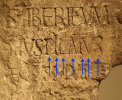The Pilate Inscription was discovered in 1961 at the city of Caesarea. The inscription is written in Latin. The first part of the name (i.e. Pontius) is damage, but the second half is very clear. I have provided blue arrows so that you can see each letter.

The letters are P I L A T V S. The letters VS are a case ending. The letter V is equivalent to our letter "u."

The letters Y and Z came into Classical Latin by way of the Greek alphabet. The Old Latin alphabet had neither letter.
Just for comparison both the Greek and the Latin are provided.
ΠΙΛΑΤΥΣ (Greek)
PILATVS (Latin)


The letters are P I L A T V S. The letters VS are a case ending. The letter V is equivalent to our letter "u."

The letters Y and Z came into Classical Latin by way of the Greek alphabet. The Old Latin alphabet had neither letter.
Just for comparison both the Greek and the Latin are provided.
ΠΙΛΑΤΥΣ (Greek)
PILATVS (Latin)


